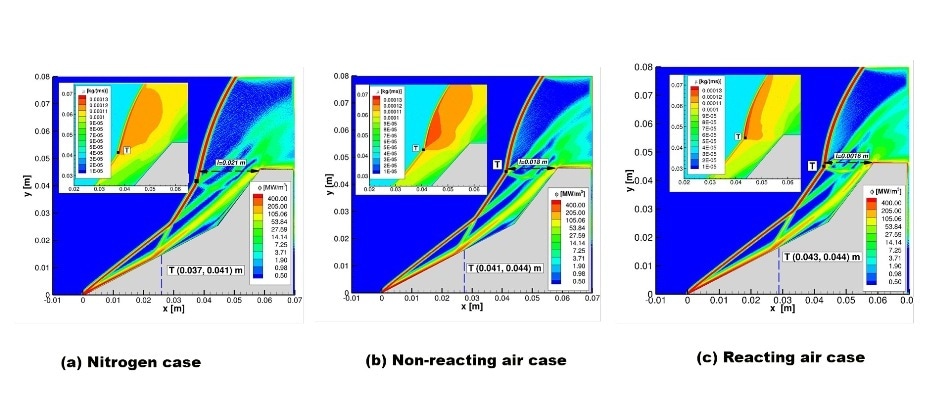Apr 24 2019
In the study of chemical reactions that take place in the flow of gases around a vehicle traveling at hypersonic speeds, scientists at the University of Illinois used a sustainable technique to acquire better insights into the role of chemical reactions in changing unsteady flows that take place in the hypersonic flow around a double-wedge shape.
 Spatial distribution of viscous dissipation. (Image credit: University of Illinois, Urbana-Champaign)
Spatial distribution of viscous dissipation. (Image credit: University of Illinois, Urbana-Champaign)
We reduced the pressure by a factor of eight, which is something experimentalists couldn’t do. In an actual chamber, they tried to reduce the pressure but couldn’t reduce it that much because the apparatuses are designed to operate within a certain region. They couldn’t operate it if the pressure was too low. When we reduced the pressure in the simulation, we found that the instabilities in the flow calmed down. We still had a lot of the kind of vortical structure—separation bubbles and swirls—they were still there. But the data were more tractable, more understandable in terms of their time variation.
Deborah Levin, Researcher, Department of Aerospace Engineering, University of Illinois, Urbana-Champaign.
Levin carried out the study together with her earlier doctoral student Ozgur Tumuklu, and Vassilis Theofilis from the University of Liverpool.
The Direct Simulation Monte Carlo (DSMC) method—a high-fidelity physical technique—was used to reproduce the hypersonic flow. However, just like any other approach, it has benefits and drawbacks. One drawback is that it forms the flow by collecting large amounts of collision data, creating reams and reams of particle data, together with statistical noise.
The DSMC outcomes were fed into a window proper orthogonal decomposition program, an example of which is called a reduced order model to make the analyses of the time behavior of the DSMC results much more viable.
“It’s a very clever method that is more tractable and can reduce computational effort,” Levin stated. “Before we had this technique, we’d select three-dimensional data of pressure, density, and temperature, which are varying throughout the whole flow over the external shape of the vehicle. We’d sit at different locations in the flow and collect data at every time step. It winds up being a treasure hunt—you look here, you look there, wherever you think there is a sensitive part of the flow where you could see some changes.
“The main difference in using WPOD is that it organizes all of that spacial data, which is changing as a function of time, and it gives you some idea as to what it thinks are the decay modes,” Levin reported.
Apart from the application of this new technique to infer data, the research group acquired new insights into the chemical reactions that take place in hypersonic flow. The research examined three types of gas compositions—molecular nitrogen, reacting air with oxygen dissociation and the nitric oxide exchange reactions, and non-reacting air containing molecular nitrogen and oxygen.
We learned about vibrational temperatures. These are usually very hard to compute. We learned about being able to predict chemical species, like nitric oxide—a compound in the gas phase, that are only present in very small amounts. It’s produced in hypersonic flows in one out of one thousand particles. It’s not a major component, like 79 percent nitrogen, but it’s very important and we wanted to be able to predict it. Using this technique, we were able to do it so much more easily. Because of that, we were able to understand what the effect of the chemistry was in the flow that produced the nitric oxide, and how that affected the different stability modes.
Deborah Levin, Researcher, Department of Aerospace Engineering, University of Illinois, Urbana-Champaign.
Tumuklu produced short videos by saving all of the data in frames, later accelerating it to demonstrate how the flow develops over time. It is hard to see with an inexperienced eye, but Levin said that the video displays the difference in the way the shocks interact for the nitrogen case that has no chemical reactions and the reacting air case of 79% nitrogen and 21% oxygen, which is the composition of air in Earth’s atmosphere.
“There is also a feature called the ‘triple point’ represented by a red dot on the video. If you look very closely, at the two videos, the triple point on the nitrogen case never moves; it stays at one location while everything moves about it.”
“But in the case of the reacting air, the triple point does move. It oscillates back and forth with everything else still moving around it,” stated Levin. “This told us what the effective chemical reactions were. They are dumping extra heat or energy into the flow, which changes the instability, the unsteady behavior.”
According to Levin, aircraft designers overdesign to make up for not knowing the correct requirements—for instance, the minimum thickness required for a heat shield.
Ultimately, through this basic research, we will get some answers, some rules of thumb for people, who are at the designing level. They won’t have to run petascale calculations, but they’ll know that if they have certain shapes at certain positions to the angle of attack, they need to worry about instabilities when designing spacecraft for safe reentry into Earth’s atmosphere or other atmospheres. They may take out a flap or reposition a flap for a control surface to minimize or prevent instabilities.
Deborah Levin, Researcher, Department of Aerospace Engineering, University of Illinois, Urbana-Champaign.
The research, “Modal analysis with proper orthogonal decomposition of hypersonic separated flows over a double wedge,” was carried out by Deborah Levin and Ozgur Tumuklu from the University of Illinois, and Vassilis Theofilis from the University of Liverpool. It is published in the journal Physical Review Fluids.
The Air Force Office of Scientific Research supported this project.